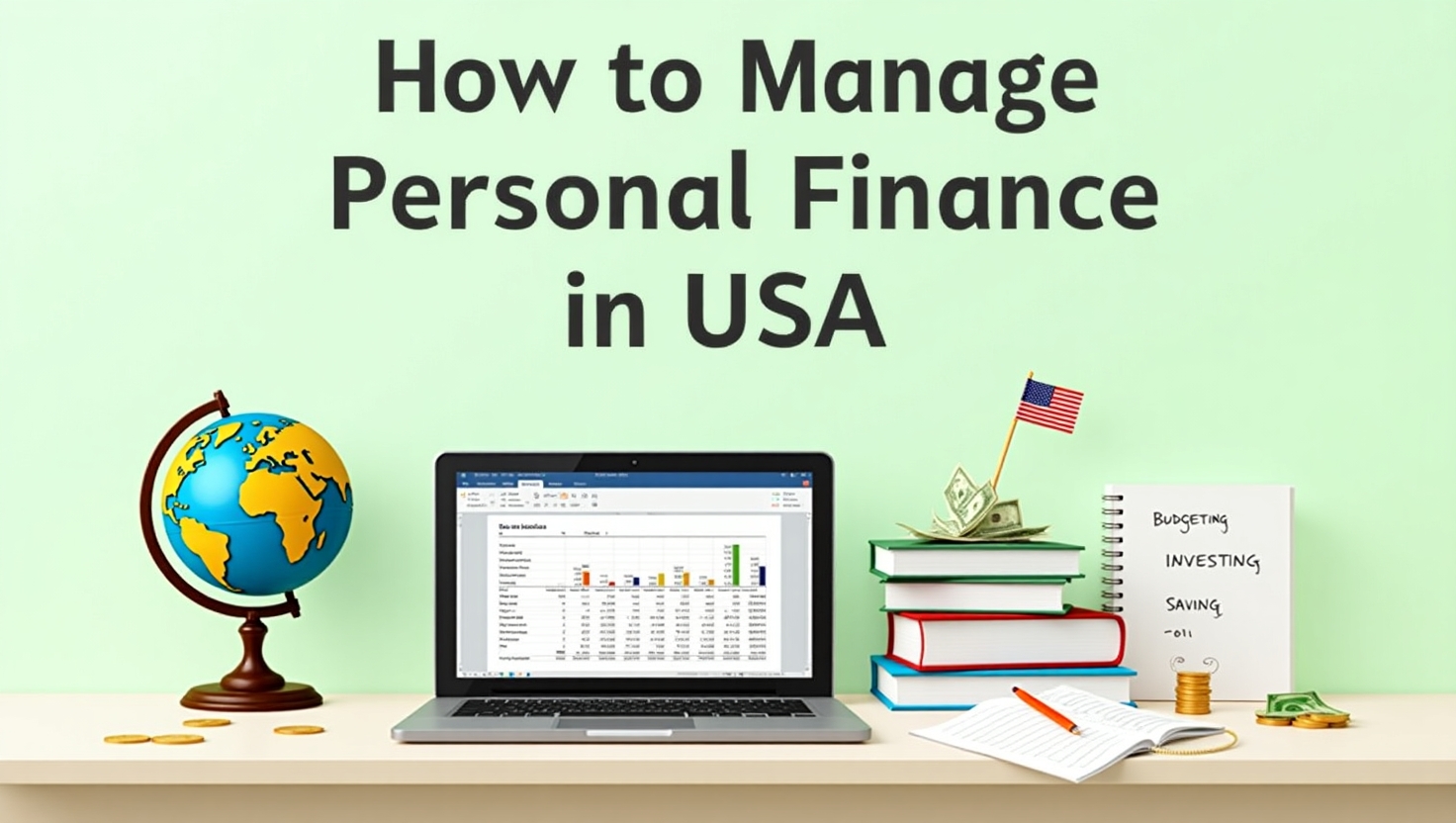How to Manage Personal Finance in USA: A Complete Guide for 2025
Managing personal finance in the USA can feel overwhelming with rising living costs, student loans, healthcare expenses, and credit card debt all demanding attention. However, with the right strategies and tools, you can take control of your finances and build a secure future. This guide will walk you through how to manage personal finance in USA, step-by-step, with practical advice tailored for American households.

1. Understanding the Basics of Personal Finance
Before diving into strategies, it’s important to understand what personal finance encompasses. It involves managing your income, expenses, savings, investments, debts, and planning for both short-term and long-term goals.
Key components include:
-
Budgeting
-
Saving
-
Debt management
-
Investing
-
Insurance
-
Retirement planning
Learning how to manage personal finance in USA starts with mastering these core elements.
2. Create a Realistic Budget That Works for You
A budget is the foundation of personal finance. Without it, you’re essentially flying blind.
💡 How to build a budget:
-
Track your income: Know exactly how much money you bring in monthly (after taxes).
-
List your expenses: Include rent/mortgage, groceries, utilities, subscriptions, gas, and entertainment.
-
Identify fixed vs. variable costs: Fixed costs don’t change (rent, loans), while variable ones (dining out, shopping) can be adjusted.
-
Use the 50/30/20 rule: Allocate 50% of your income to needs, 30% to wants, and 20% to savings or debt repayment.
🛠 Tools to help:
-
Mint
-
YNAB (You Need a Budget)
-
EveryDollar
-
Spreadsheets (Excel/Google Sheets)
A well-planned budget is the first step toward mastering how to manage personal finance in USA effectively.
3. Build an Emergency Fund
Life is full of surprises—unexpected car repairs, medical bills, or job loss can hit at any time.
📦 What is an emergency fund?
An emergency fund is a stash of money set aside specifically for unexpected expenses.
🏦 How much should you save?
-
Beginner goal: $1,000
-
Ideal goal: 3–6 months of living expenses
Open a high-yield savings account (like with Ally Bank, Marcus by Goldman Sachs, or Discover) to grow your emergency fund with interest.
4. Reduce and Eliminate Debt Strategically
America is no stranger to debt. From credit cards to student loans, debt can cripple your financial progress.
🔥 How to tackle debt:
-
List all debts: Include interest rates, minimum payments, and total balances.
-
Choose a repayment strategy:
-
Debt snowball: Pay off smallest debts first.
-
Debt avalanche: Focus on highest-interest debt first.
-
-
Negotiate interest rates: Call your lenders and ask for lower rates.
-
Consider debt consolidation: Roll multiple debts into one with a lower interest rate.
Getting rid of debt is essential when learning how to manage personal finance in USA.
5. Boost Your Credit Score
Your credit score plays a major role in getting approved for loans, renting apartments, and even landing jobs.
📈 Tips to improve your score:
-
Pay bills on time
-
Keep credit card utilization under 30%
-
Avoid opening too many new accounts
-
Check your credit report annually (at AnnualCreditReport.com)
A good score (700+) opens doors to better financial opportunities.
6. Save for Retirement Early
The earlier you start, the more time your money has to grow through compound interest.
🧓 Retirement savings options in the USA:
-
401(k): Employer-sponsored plan (check for matching contributions).
-
IRA (Traditional or Roth): Tax-advantaged individual retirement accounts.
-
HSA (Health Savings Account): Triple tax benefits if used for medical expenses.
Try to contribute at least 15% of your income toward retirement. Starting early is a key factor in mastering how to manage personal finance in USA for the long run.
7. Invest for Long-Term Wealth
Saving is good, but investing helps your money outpace inflation and grow over time.
📊 Investment basics:
-
Stocks: Higher risk, higher return.
-
Bonds: Lower risk, lower return.
-
ETFs and Mutual Funds: Diversified and beginner-friendly.
-
Real Estate: Passive income and asset appreciation.
🛠 Platforms to consider:
-
Fidelity
-
Vanguard
-
Robinhood (for beginners)
-
Charles Schwab
Don’t try to time the market. Instead, stay consistent with monthly contributions and think long-term.
8. Get Proper Insurance Coverage
One accident or illness can destroy your finances if you’re not protected.
Types of insurance you need:
-
Health insurance: Mandatory and crucial.
-
Auto insurance: Legally required.
-
Homeowners/renters insurance: Protects property and possessions.
-
Life insurance: If you have dependents.
-
Disability insurance: Covers income if you can’t work.
Insurance is not just an expense; it’s a safety net.
9. Understand Tax Planning
Taxes are unavoidable, but smart planning can help reduce your burden.
🧾 Tips to save on taxes:
-
Contribute to retirement accounts
-
Use HSA/FSA accounts
-
Claim all eligible deductions (education, mortgage interest, charitable donations)
-
Work with a tax advisor if needed
Using legal strategies to lower your taxes is a powerful part of how to manage personal finance in USA wisely.
10. Plan for Major Life Goals
Whether it’s buying a home, getting married, or sending your kids to college—every big goal needs a plan.
🏠 Smart goal-setting framework:
-
Specific: “I want to save $20,000 for a down payment”
-
Measurable: Track your progress
-
Achievable: Be realistic
-
Relevant: Align with life priorities
-
Time-bound: Set deadlines
Use separate savings accounts for each goal to stay organized and motivated.
11. Avoid Lifestyle Inflation
As your income increases, it’s tempting to upgrade your lifestyle. But this can keep you stuck in a cycle of living paycheck to paycheck.
🛑 How to avoid it:
-
Increase savings when you get a raise
-
Stick to your original budget
-
Delay gratification
Controlling spending habits is a major part of learning how to manage personal finance in USA effectively.
12. Teach Financial Literacy to Your Family
Money lessons should start early. Teaching your kids about saving, budgeting, and investing prepares them for a brighter future.
Use tools like:
-
Greenlight debit card for kids
-
Allowance tracking apps
-
Simple money books and games
13. Automate Your Financial Life
Make it easier to succeed by setting things on autopilot.
🔁 What to automate:
-
Bill payments
-
Savings transfers
-
Retirement contributions
-
Investment deposits
Automation helps you stay consistent without the need for constant reminders.
14. Stay Informed and Keep Learning
The financial world evolves constantly. Stay updated with:
-
Personal finance blogs (NerdWallet, The Balance, Mr. Money Mustache)
-
Podcasts (The Dave Ramsey Show, Planet Money, ChooseFI)
-
Books (“The Total Money Makeover”, “Your Money or Your Life”)
The more you learn, the better your decisions will be.
✅ Conclusion: Take Control Today
Learning how to manage personal finance in USA isn’t a one-time task—it’s a lifelong journey. By budgeting, saving, investing, and staying informed, you can build a future that gives you peace of mind and financial freedom. Don’t wait for the “perfect time.” Start where you are, use what you have, and commit to better money habits today.
❓FAQs
1. What’s the best budgeting method for beginners?
The 50/30/20 rule is a simple and effective way to get started.
2. How much should I save each month?
Aim for at least 20% of your income, split between emergency savings and long-term goals.
3. Is it better to invest or pay off debt first?
High-interest debt (like credit cards) should be paid off first. Then focus on investing.
4. Do I really need an emergency fund if I have a credit card?
Yes. Relying on credit cards during emergencies can lead to more debt due to interest charges.
5. How do I choose the best investment platform?
Look for low fees, ease of use, customer support, and the types of accounts offered (IRAs, brokerage accounts, etc.).

